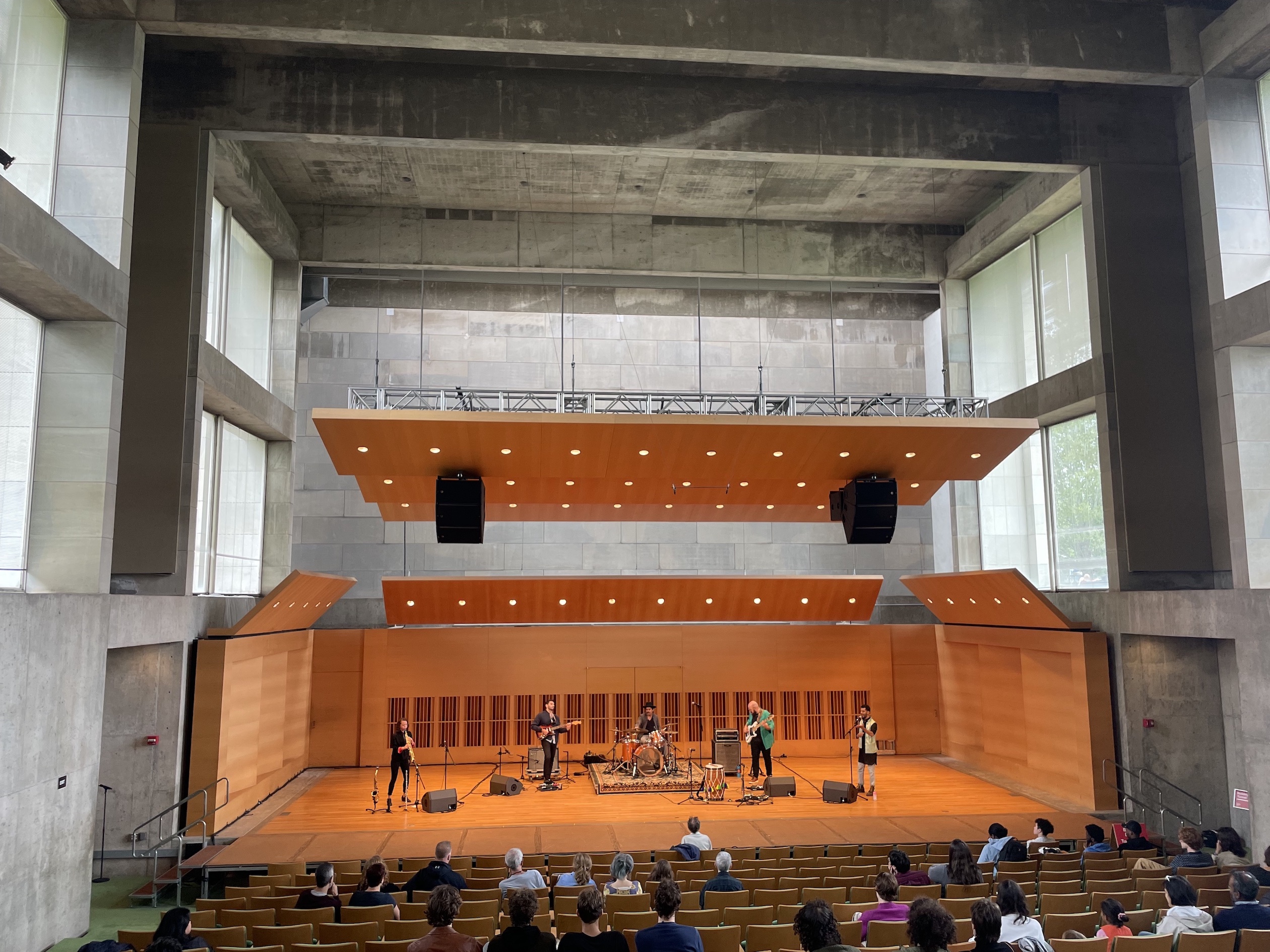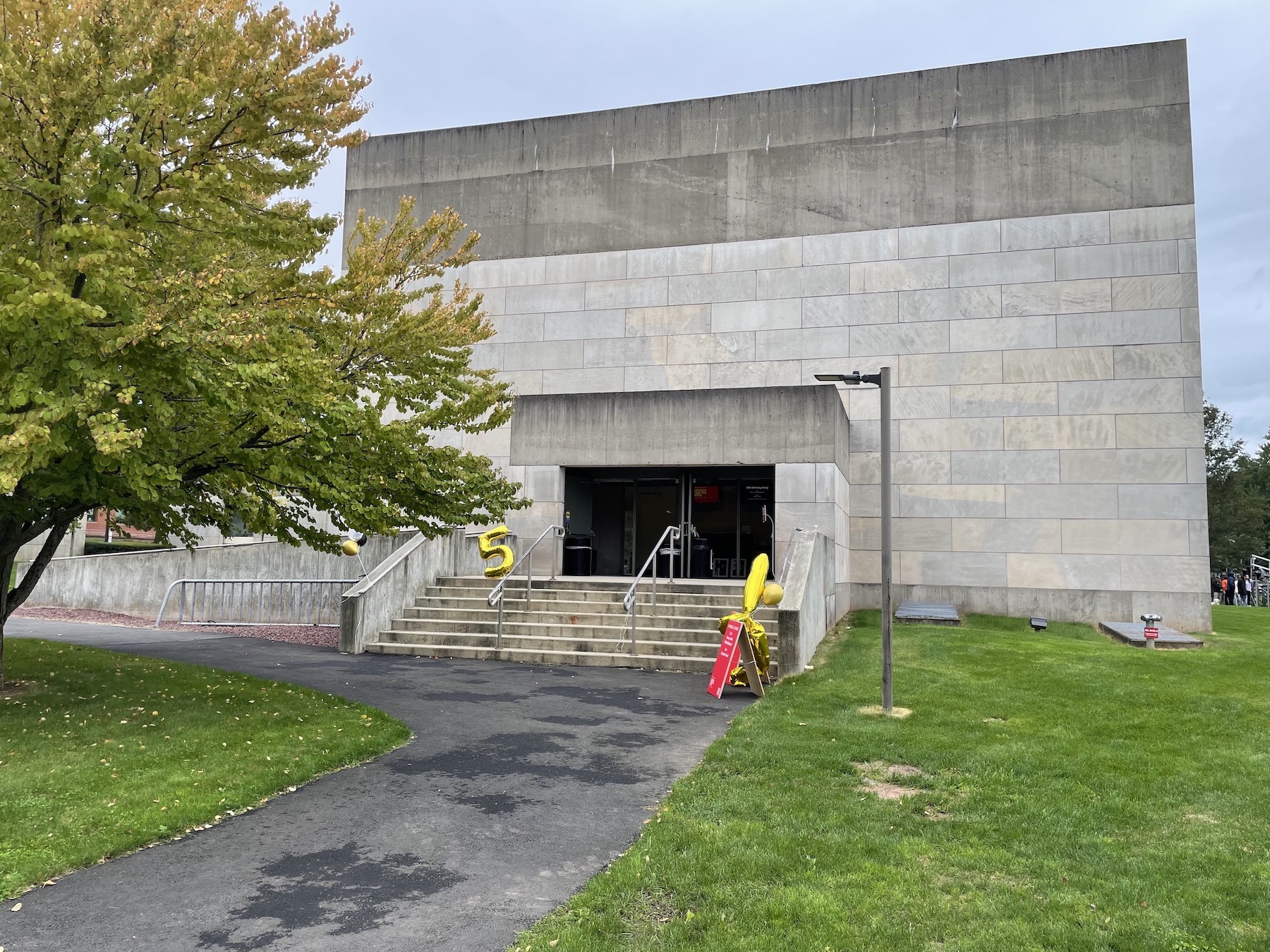
A cheerful celebration of the Center for the Arts’ (CFA) 50th anniversary took place during the rainy afternoon of Saturday, Sept. 23, sprawling throughout the various performance halls, the theater studios, and even the tunnels that connect them.
The event, affectionately called the CFA’s 50th birthday party, heralded the 50th year since the 11-building complex opened its doors to the public. It kicked off at 2:00 p.m. with “Wild Wild East,” a performance by Sunny Jain, and continued with events developed by the CFA’s summer student interns in collaboration with CFA faculty and staff. This event was a notable departure from traditional anniversary celebrations.
“In a very ‘keeping Wesleyan weird’ way, we thought it would be fun to have a birthday party for the CFA,” CFA Director Joshua Lubin-Levy ’06 said. “Ultimately we decided that the most exciting thing was to bring students into the process who have a relationship to the CFA and to get them to think further about how they would introduce the campus to these spaces and celebrate them.”

Headlining the celebration, Sunny Jain and his Brooklyn-born band kicked off the event in the Crowell Concert Hall to a crowd composed of all generations, including University students and alumni, Middletown residents, and even guests from afar. As a South Asian percussive and soundscape artist, Sunny Jain combines folk, Punjabi, jazz, rock, and South Asian musical traditions, which more broadly reflect Jain’s cultural heritage and his family’s immigration to the United States. The performance invited audience members to participate with the music—and thus Jain’s musical narrative—through both dance and vocal accompaniment. Idenya Bala-Mehta ’25 attended the concert at the encouragement of Shakti, a South Asian student organization, and enjoyed the performance.
“That genre of music is the kind of music that I find the most fun: Fusion music,” Bala-Mehta said. “I spend most of my time in academia. This is a nice [connection between] both worlds. I’m very happy to have [the CFA] right next to me.”
Continuing the afternoon, attendees were invited to take a tour of the CFA tunnels, which are the long and narrow underground spaces that connect the CFA buildings together, beginning in Crowell Concert Hall and ending at the Ring Family Performing Arts Hall. The tunnel walls were decorated with pictures of student art from introductory classes across all artistic disciplines, including architecture, life-size drawings, printmaking, sculpture, time-based video media, and CFA architectural drawings from the University archives. Turning the normally drab and gray walls into explosions of art and color is no easy feat, and Helen Townsend ’24—with the assistance of Miles Allen ’24—curated a beautiful gallery.
“The bays of light aren’t super predictable,” Townsend said. “But there are 10 of them. And so I used [all] 10 of them to show the nine different concentrations with the time-based media being in an area of darkness.”
Each work of art was displayed with information on the course number, title, and description so that students who visited could take the courses if they were inspired by the exhibit. Starting with “Drawing I” (ARST131), the foundational course of the studio art major, each separate course was highlighted in its own well of light as you moved further into the tunnels.
“I ordered it so that generally the work created above is mirrored below,” Townsend said. “So the architecture stuff is under the architecture studio. Not so true with drawing and printmaking ’cause that’s over by the Art Workshop.”
Mark Masselli, a longtime Middletown resident who attended the CFA’s opening ceremony 50 years ago, enjoyed seeing the art on display.
“It’s exciting,” Masselli said, “The tunnels are a nice place to gather. I grew up in the tunnels, probably on the other side of the campus, but I’ve traveled in many tunnels during interesting parts of Wesleyan’s history.”
Cardinal Print & Copy offered attendees the opportunity to screenprint a shirt with a custom CFA design, created using images from the archives and graphics. The print shop was crowded with visitors eager for the chance to ink one of four designs representing the CFA buildings onto new T-shirts and upcycled clothing donated by WesThrift.
“I wanted to come screenprint a shirt today because I love crafts and I need motivation to do them, ’cause I can’t motivate myself to do them without the facilities and the access to them,” Chloe Andersen ’26 said. “So this is awesome. I got a free shirt and I screenprinted it myself.”
The screen printing event was developed by Noah Shacknai ’25 and Spencer Klink ’24, who recruited other students to help them run screen printing stations and teach guests how to use them.
“I took a printmaking class last semester, and it was the best thing ever: I’m now a printmaking major, so this is my thing,” Lena Wyman ’25 said. “Spencer, who’s in charge of the screenprinting, was my TA last year and he reached out to me [to help] ’cause I’m a printmaking major.”
Merce Cunningham and Charles Atlas’ “Walkaround Time,” on display in the Ring Family Performing Arts Hall, was one of three recordings that were playing in various venues across the CFA during the birthday party. Projected in a small basement theater, “Walkaround Time” invited its small and constantly changing crowd of viewers to consider a theatrical representation of the slower processing speeds of older computers. In an abstract (and very Wesleyan) sense, “Walkaround Time” provided a choreographed embodiment of space and time for its dispersed audience to pause and reflect.
“It was just sort of a dream of mine because the early renderings of the CFA used photos from this performance,” Lubin-Levy said, “So there’s a kind of beautiful philosophy to it. Just to think that there’s something about that work that’s once again rooted in the CFA.”
The other two recordings included John Cage’s “Empty Words” in Crowell Concert Hall—taken from a recording of a performance called “An Evening with John Cage” that premiered in Crowell in 1974—and Trisha Brown’s “Skymap” in the CFA Theater, an audio recording with instructions for the audience to imagine choreography for a dance intended to happen on the ceiling of the theater.
“One of the things we wanted to do is really celebrate that these are beautiful spaces when you really start to look at them,” Lubin-Levy said. “I think that we tend to go into these environments and you focus on the live act, so the media works allowed people to have an interesting experience in the spaces.”
The architectural layout of the CFA itself also played a role in the organization of the event. Had it not rained on the day of the celebration, the live performances and certain activities were originally supposed to take place outside. This structure was established to highlight the original architectural intent behind the organization of the CFA.
“The hope would be that people would be going into buildings to capture the media works, but otherwise spending most of their time outside,” Lubin-Levy said. “The architects who designed these spaces were really considerate about the spaces in between the buildings. So that’s where our student interns really wanted to set up their work.”
For many years, the CFA’s layout has left an impression on University students and visitors. Karen Kalina ’85 recognized this lasting importance of the CFA and its layout at the celebration.
“It was part of the reason I came to Wesleyan,” Kalina stated. “When I did the college tour, I saw this art center, and I just thought it was a fantastic idea, the way they had built the buildings around the trees. I just really appreciated that.”
Other events were more structured around pulling visitors in as participants, such as a lively and well attended pop-up salsa class led by Rebecca Trevino ’24 in the CFA Theater, a collective mural complementing the “No Title: Relays + Relations” exhibition that opened on Tuesday, Sept. 26, and an activity where participants constructed human-sized paper flowers. Watching everyone—from little kids to college students, from alumni to Middletown residents—work together to create huge flowers was particularly inspiring, as all of their work will be on display in a performance by visiting artist Deborah Goffe MA ’19 in February 2024. Everyone at the event who felt musically inclined came together to participate in a world music jam led by Emma Bella Bass-Lawrence ’24. A hidden delight was the costume shop photo booth, where you could dress up in costumes owned by the theater department and pose for photos.
As an official toast to the CFA’s 50th Birthday, there was a cupcake ceremony in the Crowell Concert Hall at 4:00 p.m. to kick off the final hour of the event. The ceremony featured three speeches—from Lubin-Levy, Dean of the Arts and Humanities Roger Mathew Grant, and Connecticut State Senator Matt Lesser—as well as a collection of 250 vanilla, chocolate, and funfetti cupcakes, fifty for each of the five departments in the CFA.
“We’re not doing an anniversary,” Grant said. “We’re doing a birthday party for buildings and for the people that fill them and the art that has filled them over fifty years.”
This event was ambitious, expansive, and everything Lubin-Levy hoped would continue during his tenure as CFA director, which began last year. A recent structural change has separated the CFA staff into two separate teams: Lubin-Levy’s team, which focuses on curation, public engagement, and visual and performing arts, and a team led by Producing Director for the Arts Drew Gray, who works with the technical staff to execute the other team’s visions. This new, collaborative approach has opened doors for the direction of future CFA programming.
“You can see [the structural change] reflected in the 50th birthday party; we did this as a collective, we shared thoughts and opinions,” Lubin-Levy said. “We met every week to talk about what we wanted to see happen. Everybody took up their responsibility for it, and it filled the CFA in a way that we haven’t in many, many years.”
Students who are inspired by the CFA’s collaborative vision are encouraged to come forward and work to realize their own projects and events.
“My door is always open, and I’m really excited to talk about arts projects that students have in mind,” Lubin-Levy said. “Although the CFA is not always the best host for everything, we can be a great thought partner in helping to realize things and to brainstorm ideas.”
Spencer Landers contributed reporting and can be reached at sklanders@wesleyan.edu.
Caleb Henning can be reached at chenning@wesleyan.edu.
Brodie Zeigler can be reached at bzeigler@wesleyan.edu.



Leave a Reply